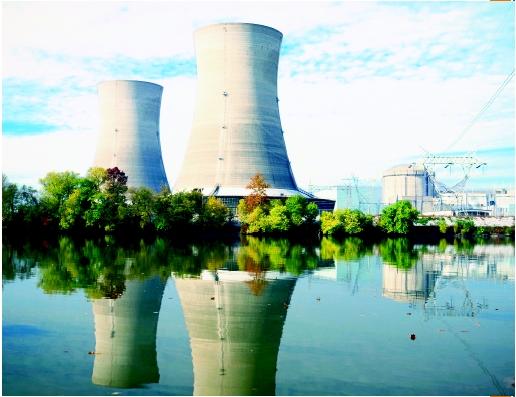The advantages of using Nuclear Power should be apparent to everybody with common sense, especially now with the resurfacing of the Global Warming and the Federal Deficit. Approximately 20% of the Federal Deficit is the value of imported oil.
The politics of nuclear energy, however, is rather complicated. In the U.S. the Congress has mainly favored nuclear energy, with the Republicans more so than the Democrats. Around 1990 a bill simplifying the licensing process for new plants became law. In the early 90s Congress voted to store nuclear waste in Nevada if the studies turned out favorable. Lengthy studies came out favorable around 2000, and in 2002 Congress voted to override the opposition oft he State of Nevada. Apparently lawsuits will tie up actual construction for a while, but it is expected that the storage of waste in Nevada will begin around 2010. There has been a virtual moratorium on nuclear power plants in the United States during the past generation, and it has many causes. But one significant factor in the industry's decline was the Nuclear Regulatory Commission's (NRC) licensing process. This process didn't allow approval of the plants until after construction. This caused many costly delays while the completed plants were idling waiting for their operating licenses.
There has been a virtual moratorium on nuclear power plants in the United States during the past generation, and it has many causes. But one significant factor in the industry's decline was the Nuclear Regulatory Commission's (NRC) licensing process. This process didn't allow approval of the plants until after construction. This caused many costly delays while the completed plants were idling waiting for their operating licenses.
The old regulatory process, established in 1956, had been widely seen as a cumbersome failure. In 1992, the NRC established two new processes to streamline nuclear plant licensing. By 2003, however, after the September 11 attacks, the California blackouts, the steep rise in the cost of gas powered electricity and the growing concerns of global warming, nuclear power again became an option.
In contrast to the old Part 50 procedure, the new 10-CFR 52 or "Part52" regulation aim to settle questions about sitting, design, and operating licensing issues well before you start construction. Standardization of every aspect of an application's form and contest is also a crucial feature of Part 52. With this approach, the NRC will have to review and approve a specific design only once. After that, NRC needs to check only the areas where the applicant differs, such as environmental characteristics of the specific site.
According to Mechanical Engineering, October 2007, other future reactors will likely be one of the two designs below:
1. The AP-1000 power plant designed by Westinghouse, 1.1 gigawatt pressurized water reactor. According to Westinghouse, the design features two steam generators connected to the reactor pressure vessel and an array of passive safety system that don't require AC power or cooling water to be operational.
2. The other plant is General Electric design called the Economic Simplified Boiling Water reactor. The recirculation and safety system pumps have been replaced by natural gravity-driven water circulation and passive safety systems.
A switch to nuclear energy will cause there to be economic winners and losers. The potential losers will be tempted to resist the process politically.The winners, of course, are the nuclear industry itself as well as the construction industry. The public in general will win too. The losers are the coal industry, the oil industry, and the alternative energy industry. The alternative energy industry hasn't generated an appreciable amount of energy but has absorbed much Government money, and has absorbed much research energy in the academic world.
The capital cost for electric power plants is in the neighborhood of $1000 per installed kilowatt. It is somewhat lower for gas-fired turbines and often much higher for some nuclear plants (where construction delays and post facto safety regulations have raised costs considerably). These capital costs will have been largely amortized for nuclear plants whose license to operate is being extended.
Fueling a reactor for one year requires approximately 350,000 lb of raw uranium to produce about 1,000 MW of electricity for about 7500 hours. At $10 per pound, this is 0.04 cents per KW-h. These are rough numbers I found them in my notes.
Over 78% of French electricity demands are met by nuclear energy.This was one of the goals of the French Nuclear program, to decrease French dependence on foreign energy sources. As of September 30, 2007 there were a total of 197 nuclear power plant units with an installed electric net capacity of 169,842 MWe in operation in Europe and 12 units with 9,991 MWe were under
construction in five countries.
For Nuclear Power Plants in USA Statistics (Photius Coutsoukis) click the link below:
http://www.allcountries.org/uscensus/967_nuclear_power_plants_num
http://www.allcountries.org/uscensus/967_nuclear_power_plants_number_capacity_and.html
Have a Great Success
Gabriel Kazakias
http://www.wisenet-global.com
gabe314@optonline.com
Check the "Private Stash" of our site for more interesting articles.
http://wisenet-global.com
My name is Gabriel Kazakias. I am presently a retiree spending most of my time maintaining our website. I am a graduate mechanical engineer with a Bachelor's and Master's Degrees having more than twenty five years experience working as a Project Manager for a major Nuclear Power Plant Utility.
If you were going to ask me if Nuclear Plants are safe, the answer is absolutely yes. The people that I came across not only in my plant but also during my visits to other Nuclear Utilities through out the country are the most sincere professionals that I have seen in my life.